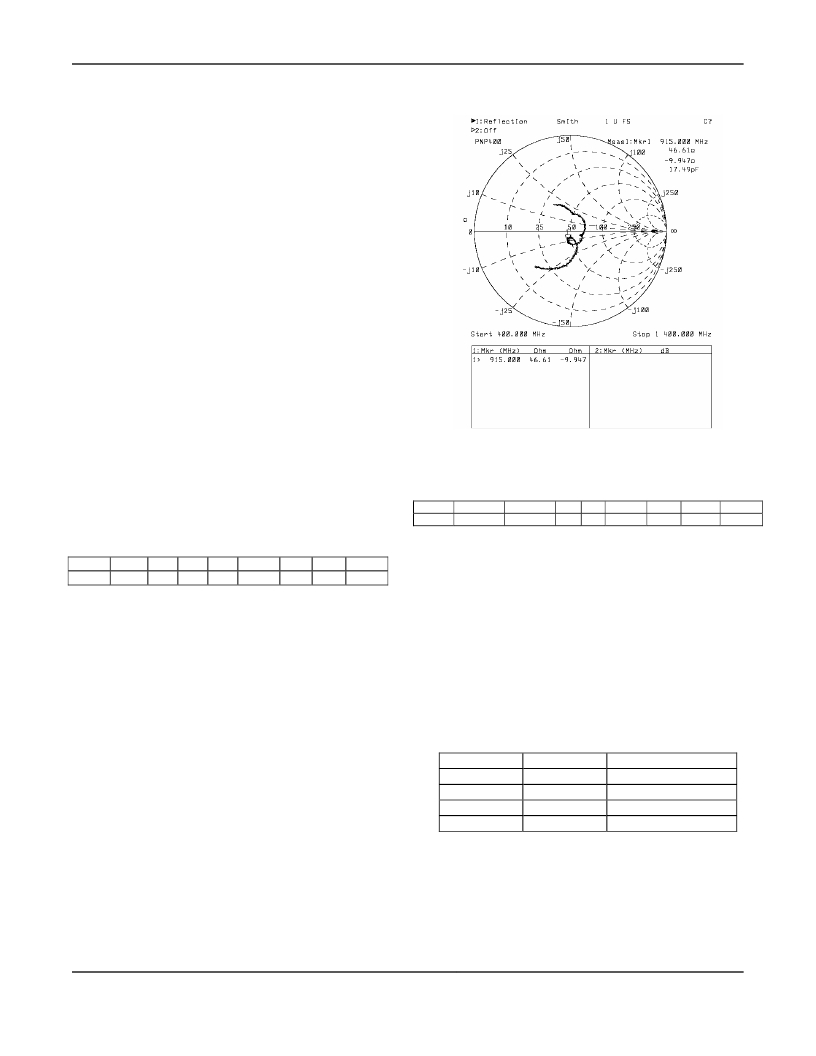- 您现在的位置:买卖IC网 > Sheet目录477 > MICRF505DEV1 (Micrel Inc)KIT DEV RADIOWIRE 850-950MHZ

Micrel
Receiver
The receiver is a zero intermediate frequency (IF)
type in order to make channel filtering possible with
low-power integrated low-pass filters. The receiver
consists of a low noise amplifier (LNA) that drives a
quadrature mixer pair. The mixer outputs feed two
identical signal channels in phase quadrature. Each
channel include a pre-amplifier, a third order Sallen-
Key RC lowpass filter from strong adjacent channel
signals and finally a limiter. The main channel filter is
a switched-capacitor implementation of a six-pole
elliptic lowpass filte. The elliptic filter minimizes the
total capacitance required for a given selectivity and
dynamic range. The cut-off frequency of the Sallen-
Key RC filter can be programmed to four different
frequencies: 100kHz, 150kHz, 230kHz and 340kHz.
The demodulator demodulates the I and Q channel
outputs and produces a digital data output. If detects
the relative phase of the I and Q channel signal. If
the I channel signal lags the Q channel, the FSK
tone frequency lies above the LO frequency (data
‘1’). If the I channel leads the Q channel, the FSK
tone lies below the LO frequency (data ‘0’). The
output of the receiver is available on the DataIXO
MICRF505BML/YML
Figure 12. LNA Input Impedance
pin. A RSSI circuit (receive signal strength indicator)
indicates the received signal level.
Sallen-Key Filters
A6..A0 D7 D6
D5
D4
D3
D2
D1
D0
0000001
Modulation1
Modulation0
‘0’
‘0’
RSSI_en
LD_en
PF_FC1
PF_FC0
Front End
A6..A0 D7
0000000 LNA_by
D6
PA2
D5
PA1
D4
PA0
D3
Sync_en
D2
Mode1
D1
Mode0
D0
Load_en
Each channel includes a pre-amplifier and a prefilter,
which is a three-pole Sallen-Key lowpass filter. It
protects the following switched-capacitor filter from
A low noise amplifier in RF receivers is used to
boost the incoming signal prior to the frequency
conversion process. This is important in order to
prevent mixer noise from dominating the overall
front-end noise performance. The LNA is a two-
stage amplifier and has a nominal gain of
approximately 23dB at 900MHz. The front end has a
gain of about 33dB to 35dB. The gain varies by 1-
1.5dB over a 2.0V to 2.5V variation in power supply.
strong adjacent channel signals, and it also works as
an anti-aliasing filter. The preamplifier has a gain of
22-23dB. The maximum output voltage swing is
about 1.4Vpp for a 2.25V power supply. In addition,
the IF amplifier also performs offset cancellation.
Gain varies by less than 0.5dB over a 2.0 – 2.5V
variation in power supply. The third order Sallen-Key
lowpass filter is programmable to four different cut-
off frequencies according to the table below:
The LNA can be bypassed by setting bit LNA_by to
‘1’. This can be useful for very strong input signal
levels. The front-end gain with the LNA bypassed is
about 9-10dB. The mixers have a going of about
10dB at 915MHz. The differential outputs of the
mixers can be made available at pins IchOut and
PF_FC1
0
0
1
1
PF_FC0
0
1
0
1
Cut-off Freq. (kHz)
100
150
230
340
QchOut. The output impedance of each mixer is
about 8k ? .
The input impedance is close to 50 ? as shown in
Figure 12, giving an input reflection of about -20dB.
The receiver does not require any matching network
to optimize the gain. However, a matching network is
recommended for harmonic suppression in Tx and
for improved selectivity in Rx.
October 2006
20
M9999-103106
+1 408-944-0800
发布紧急采购,3分钟左右您将得到回复。
相关PDF资料
MICRF506DEV1
EVAL BOARD EXPERIMENTAL MICRF506
MICRF507YML TR
TXRX FSK LOW PWR W/AMP 32MLF
MICRF600DEV1
KIT DEV RADIOWIRE 902-928MHZ
MK01-C
SENSOR REED SPST-NO SMD
MK01-H
SENSOR REED SPDT-CHANGE SMD
MK02/0-1A66-500W
SENSOR REED SPST-NO
MK02/6-0
SENSOR REED PCB 24MM T/H
MK03-1C90C-500W
SENSOR REED SPDT CYLINDER
相关代理商/技术参数
MICRF505DEV1
制造商:Micrel Inc 功能描述:KIT MICRF505 EVALUATION
MICRF505L
制造商:MICREL 制造商全称:Micrel Semiconductor 功能描述:850MHz and 950MHz ISM Band Transceiver
MICRF505LYML
制造商:Rochester Electronics LLC 功能描述: 制造商:RF Micro Devices Inc 功能描述:
MICRF505LYML TR
功能描述:射频收发器 850MHz to 950MHz, 2.25V to 5.5V FSK Transceiver with +10dBm Power Amplifier
RoHS:否 制造商:Atmel 频率范围:2322 MHz to 2527 MHz 最大数据速率:2000 Kbps 调制格式:OQPSK 输出功率:4 dBm 类型: 工作电源电压:1.8 V to 3.6 V 最大工作温度:+ 85 C 接口类型:SPI 封装 / 箱体:QFN-32 封装:Tray
MICRF505YML
制造商:Micrel Inc 功能描述:433/915MHZ ITRANSCEIVER SMD MLF32 制造商:Micrel Inc 功能描述:433/915MHZ ITRANSCEIVER, SMD, MLF32 制造商:Micrel Inc 功能描述:433/915MHZ ITRANSCEIVER, SMD, MLF32; Frequency Min:850MHz; Frequency Max:950MHz; Modulation Type:FSK; Sensitivity dBm:-111dBm; Data Rate:200Kbps; Supply Voltage Min:2V; Supply Voltage Max:2.5V; RF IC Case Style:MLF; No. of Pins:32; ;RoHS Compliant: Yes
MICRF505YML TR
功能描述:射频收发器 850MHz to 950MHz, 2.0V to 2.5V FSK Transceiver with +10dBm Power Amplifier
RoHS:否 制造商:Atmel 频率范围:2322 MHz to 2527 MHz 最大数据速率:2000 Kbps 调制格式:OQPSK 输出功率:4 dBm 类型: 工作电源电压:1.8 V to 3.6 V 最大工作温度:+ 85 C 接口类型:SPI 封装 / 箱体:QFN-32 封装:Tray
MICRF505YML-TR
功能描述:IC RF TxRx Only General ISM < 1GHz 850MHz ~ 950MHz 32-VFQFN Exposed Pad, 32-MLF? 制造商:microchip technology 系列:- 包装:剪切带(CT) 零件状态:有效 类型:仅限 TxRx 射频系列/标准:通用 ISM < 1GHz 协议:- 调制:FSK 频率:850MHz ~ 950MHz 数据速率(最大值):200kbps 功率 - 输出:10dBm 灵敏度:-111dBm 存储容量:- 串行接口:SPI GPIO:- 电压 - 电源:2 V ~ 2.5 V 电流 - 接收:8.6mA ~ 13.5mA 电流 - 传输:14mA ~ 28mA 工作温度:-40°C ~ 85°C 封装/外壳:32-VFQFN 裸露焊盘,32-MLF? 标准包装:1
MICRF506
制造商:MICREL 制造商全称:Micrel Semiconductor 功能描述:410MHz and 450MHz ISM Band Transceiver
